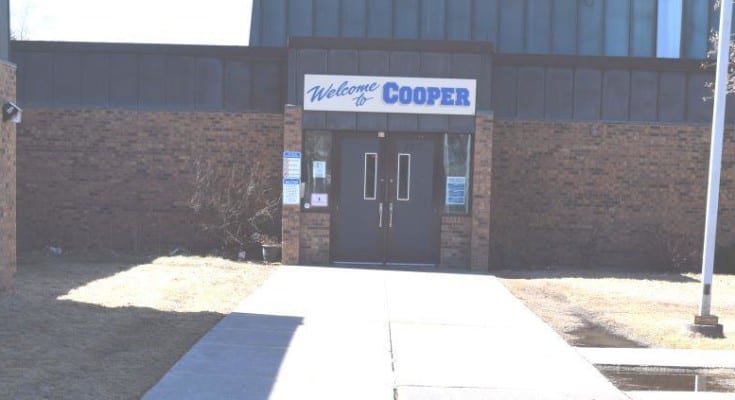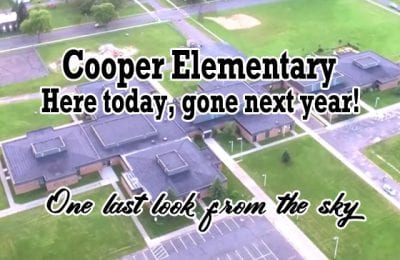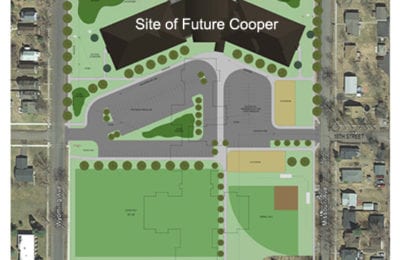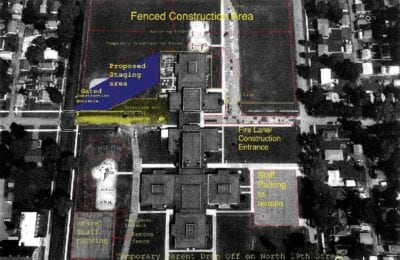Why Does Cooper Need to be Replaced?
By Gary Niemi
Cooper Elementary School was opened in 1970. It is now 45 years old and has numerous deficiencies that need to be addressed. If there were only one or two building deficiencies, it would be cost effective to correct them but that is not the case with Cooper. The school has many and diverse deficiencies. Correcting these would be cost prohibitive.
A 2005 FacilitiesNet article by Clif Greim says,
“schools built in the 1960s and ’70s generally lack architectural character, are not energy-efficient and are constructed of cheaper materials.”
This description fits Cooper to a tee. Additionally, according to the U.S. Department of Education, most schools are abandoned by the age of 60. In this article they state that:
“when a school is 20 to 30 years old, frequent replacement of equipment is needed. Between 30 and 40 years old, the original equipment should have been replaced, including the roof and electrical equipment. After 40 years, a school building begins rapid deterioration, and after 60 years most schools are abandoned.”
At forty-five years old, Cooper is fast approaching the point at which school buildings are abandoned.
Finally, in a 2004 study of various buildings demolished in Minneapolis, 56% of the commercial buildings were demolished within 50 years of construction. All these point to Cooper being at the end of its building life (it bears mentioning in this regard that our current high school building opened in 1964 and will graduate its 51st class this spring).
Design Deficiencies of Cooper Elementary

Cooper Elementary “pod” type Classroom | Explore Superior©
First and foremost is educational adequacy. The school building is not economically adaptable to current and future educational needs. The school has an open floor plan, a popular concept at the time it was built. However, open classrooms lead to problems with noise and poor ventilation.
This quote from NoiseAndHealth.org speaks to some of these problems:
“Having become popular for educational reasons in the 1960’s and 1970’s, many open plan designs were found to be impractical and difficult to teach in because of problems of noise and visual distraction. For these, and other, reasons, many previously open plan schools have had remedial work to convert them to conventional enclosed classroom designs, or to a “semi-open” plan layout. The majority of new schools built in the latter part of the 20th century opted for the more traditional design with enclosed classrooms.”

Lunch is served in the gym everyday at Cooper, necessitating daily setup and breakdown of tables.
At Cooper there is no separation of classroom acoustics. This is a major disruption of the learning process. In addition, mechanical rooms are located directly above classroom areas creating noise and vibrations in classrooms below. Teachers are working around these problems, but work-arounds only go so far.
Also because of this open plan there are no real hallways in the educational “pods” at Cooper. One class has to walk through another class’ space to get into the core areas of the building to go to the gym, cafeteria, library, etc.
Other issues affecting education adequacy are that the building is disjointed and spread out making grade level collaboration and instruction more difficult. The gym and cafeteria are a shared space. This adversely affects current PE requirements and makes the transitions from PE to lunch, and back to PE extremely labor intensive. This transition happens everyday, all year long, through the school year.

This space was designed as a common pod storage area and break room
Storage spaces have been re-purposed for instructional spaces. Since storage is needed, common areas are used for storage. This creates clutter, which adds to the educational confusion created by the building itself.
There is a classroom shortage due to the advent of new programs such as SAGE and the K4 program. The school also has limited power and data receptacles within classrooms. This makes it more difficult to incorporate new technology into the educational experience.
Safety & Security Concerns

Typical classroom exit doors at Cooper.
Cooper’s physical structure create numerous safety and security concerns. Nearly every classroom has a door to the exterior. Due to the open floor plan there are no exit corridors and the designers had to put fire exit doors everywhere in the school.
A door that is inadvertently ajar is a breach of the school’s security perimeter. With many doors that could potentially be open, the chances of having an unwanted person enter the school increase.

The site traffic flow creates many vehicle pedestrian conflicts and increases the accident potential.
The main entry is not directly visible by the front office. Office staff have to rely on the buzzer system camera for a view of who is coming into the school. Unfortunately, cameras can be fooled. Not only does the disjointed and sprawling structure of Cooper affect educational adequacy, but it also raises serious security issues.
The spread out design of Cooper with so many doors to the outside, makes it difficult to monitor, and takes longer to respond to and control incidents that may occur throughout the school. Additionally, the dynamics of site and traffic circulation creates other safety issues. Crisscrossing traffic circulation patterns for staff parking, student drop-off by parents, and bus drop-off of students increases the potential for an accident. Quite simply, our students are at risk due to current design of Cooper.
Code Issues Also a Concern
There are also building code issues with Cooper. One of them is the existing ventilation system which is not capable of providing ventilation levels that comply with current building codes. This fact does not even address the fresh air levels that lead to optimum learning.
Also, the building needs a fire suppression system. This would be very disruptive to add to the existing building and may even require that ceilings throughout the building be lowered to accommodate the extra piping.

Water ponding on the roof of Cooper School
The roof at Cooper needs to be replaced. It is at the end of its expected life. There are around 100 blisters on the roof surface. These indicate that water has penetrated the roof plies and have a high potential to cause a leak. Fixing each of these potential leaks would mean replacing nearly half the roof with patches, and there is no guarantee that the roof membrane adjacent to the patch would not fail in the near future.

Outside Cooper on a rainy day
When the school was originally built, the building was not elevated sufficiently above the existing site. Because the site is so flat and no provisions were made for adequate site drainage, water from rain and snow sits on the ground surface next to the building.
This saturates the ground around and under the school and makes the building and surrounding area very damp. Although we continue to monitor the school closely for water related problems, standing water near the school can lead to unhealthy conditions.

Spalling, caused by moisture freezing inside the brick, damaged this corner. We needed to cut out and replace the brick a few years ago.
The dampness also damages masonry construction and other finishes in the school. Another consequence of having standing water next to the school is that during the Fall and Spring this water often freezes on sidewalks creating unsafe conditions and forces us to use excessive salt and grit to treat these areas.
The construction of the exterior walls at Cooper has its brick veneer laid up abutting the concrete block back-up wall with no vapor barrier. Since brick is not waterproof, windblown rain water enters the wall with no way to escape. This leads to deterioration of the exterior walls of the school.
The dampness also gets to the inside of door and window frames. The steel frames then rust away from the inside as well as the outside. At least the outside we can maintain and paint. Inside deterioration requires cutting out and replacing.
Energy Costs High
 The exterior wall construction also leads to high energy use by this building. There is no air barrier in the wall system, so the wind pushes outside air through the wall cooling off the interior during winter months. In some locations the exterior walls have no insulation, but nowhere in the school is the wall insulation any thicker than 1 ½” of fiberglass insulation installed between furring strips on the inside of the walls. This explains the fact that even though Cooper is about the same size in square feet as Bryant and Great Lakes, it uses about 30% more energy that those other two schools.
The exterior wall construction also leads to high energy use by this building. There is no air barrier in the wall system, so the wind pushes outside air through the wall cooling off the interior during winter months. In some locations the exterior walls have no insulation, but nowhere in the school is the wall insulation any thicker than 1 ½” of fiberglass insulation installed between furring strips on the inside of the walls. This explains the fact that even though Cooper is about the same size in square feet as Bryant and Great Lakes, it uses about 30% more energy that those other two schools.
Contributing to Cooper’s energy use are the building’s control systems. We are using a modern computer based controller for the head end, but it is trying to heat and ventilate the building using the original, 45 year old components. These are incapable of controlling the system adequately and consequently waste energy.
Heating air travels through ducts that are inadequately insulated, have unknown leaks, and some are even buried underground beneath the school. In order to maintain some fresh air ventilation of the school, we must discharge heated air directly outside. Energy recovery systems could reuse some of this lost heat, but are prohibitively expensive to install in the multiple, cramped air handling rooms throughout the building.

A white vinyl tile (no asbestos) patch where tan vinyl asbestos tile had cracked. Cooper is the only elementary school in the District that contains asbestos building materials.
Asbestos Building Materials
Another artifact of Cooper’s construction history is that this is one of two schools in the District that have asbestos containing building materials. The other is the high school. Per Federal regulations, we do inspect these materials every 6 months and repair or replace them as necessary. However, they still remain and add cost and complication to any work we need to do in the school.

Asbestos pipe insulation at Cooper Elementary.
Myriad Problems Make Replacement Necessary
As I mentioned at the outset of this article, there is no single issue that require we replace Cooper. It is the sheer quantity and diversity of problems with the school that make this step necessary. The School District of Superior cannot afford to fix each problem separately. This leaves replacement as the preferred and best solution.
How the District Plans to Make This Happen

New Cooper to be built on northern end of property (top of picture). Footprint of current building shown as black dashed line.
Cooper students would not be displaced during construction of a new building. Instead, we would first build the new building at the northern end of the Cooper property, and then after removing all salvageable materials from the old building, we would demolish the old school.
This plan allows education to continue in the existing building, and then move seamlessly into a bright, new educational environment in the new Cooper Elementary School. If you have any further questions about our plans for Cooper, the high school, or any other plans related to the proposed school referendum, please go to our website www.SuperiorReferendum.com.
Also, I invite you attend our next public meeting at Superior High School on Wednesday, March 30th at 6 pm. Additionally, our FAQ section on the website has many answers to commonly asked questions. Thank you for taking the time to consider the facts at hand.




